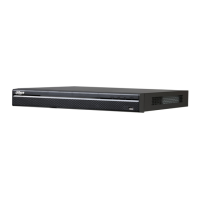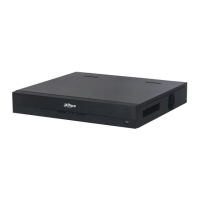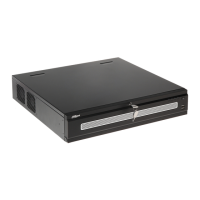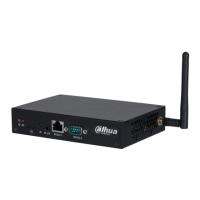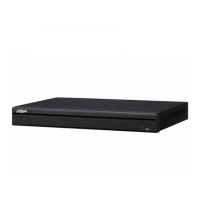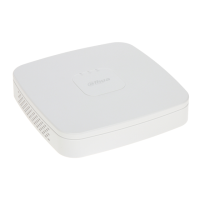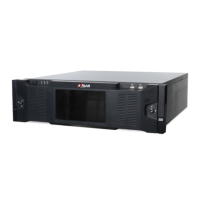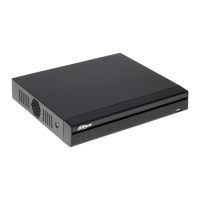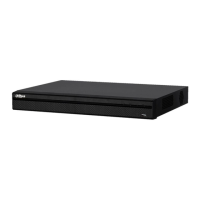
Do you have a question about the Dahua DHI-NVR5208-4KS2 and is the answer not in the manual?
| Brand | Dahua |
|---|---|
| Model | DHI-NVR5208-4KS2 |
| Category | Network Hardware |
| Language | English |
Provides categorized signal words with defined meanings for potential hazards in the manual.
Provides a high-level introduction to the NVR series product and its features.
Details key functionalities including Cloud Upgrade, Surveillance, Playback, User Management, Storage, and Alarm.
Allows for online firmware updates for NVRs connected to the internet.
Describes video output ports, preview shortcuts, and PTZ control features.
Details support for various playback modes, record search, and download capabilities.
Explains group-based management powers and user assignment to exclusive groups.
Covers backup options, including alarm setup and schedule setup for data backup.
Details how the system responds to external alarms and processes alarm inputs.
Details the components and indicators found on the front panel of various NVR models.
Details the ports and connectors found on the rear panel of various NVR models.
Introduces initial settings like boot up, device initialization, password reset, and quick settings.
Guides on connecting the NVR to power, monitor, mouse, and initiating the boot-up process.
Guides through setting a login password for the admin user and configuring unlock patterns.
Explains methods to reset the admin password if forgotten, including QR code and security questions.
Details how to enable the password reset function for local menu QR code access.
Describes the process of resetting the password via the SYSTEM LOGIN interface using patterns or security questions.
Covers camera connection, IP address changes, remote initialization, and firmware upgrades.
Covers registering remote devices to NVR, viewing video, and managing storage.
Explains how to change the IP address of cameras, including batch updates.
Details exporting the added device list to a local USB device.
Describes importing IP addresses from a USB device to add devices.
Guides on changing remote device login password and IP address, and initializing cameras.
Explains how to set network camera parameters for optimal video effects.
Covers setting video bit stream parameters like type, compression, and resolution.
Details how to set snapshot mode, image size, quality, and interval for capturing images.
Allows setting customized names for camera channels.
Explains how to upgrade connected network camera firmware via online or file methods.
Provides information on viewing connection and alarm status of corresponding channels.
Allows viewing IP address, manufacturer, type, and system version of connected remote devices.
Describes entering the multiple-channel live view mode to monitor video from each channel.
Details how to view monitor video of each channel, displaying date, time, and name.
Explains quick operations using icons on the navigation bar for menu access and view layout.
Shows channel status including alarm, record, connection, and bit rate information.
Allows playback of the previous 5-60 minutes of current channel recordings.
Allows zooming in on specific areas of a channel for detailed viewing in live or multi-channel modes.
Enables recording video clips and saving them to a USB storage device.
Allows taking multiple snapshots of video and saving them to a USB storage device.
Facilitates voice interaction between the device and remote devices for improved communication.
Enables switching between main and sub streams based on current network bandwidth.
Provides quick access to functional interfaces and operations via a context menu.
Allows setting customized view layouts and managing channel sequences.
Covers de-warping fisheye camera video for proper viewing, including installation and display modes.
Displays instant temperature readings from connected front-end devices supporting temperature detection.
Displays AI analysis results like human face, vehicle, and non-motor vehicle information.
Allows selection of attributes to display for face, human body, and vehicle detection results.
Explains PTZ functionality, including horizontal/vertical movement and remote control.
Details setting PTZ parameters for local and remote types, including protocol and address.
Describes the PTZ control panel for directing the camera, adjusting zoom, focus, and iris.
Covers configuring presets, tours, patterns, and autoscan for PTZ cameras.
Explains how to call configured PTZ functions like presets, tours, patterns, and autoscan.
Covers 24-hour continuous recording and customized record periods/types.
Details searching and playing back recorded files on the NVR.
Allows playback of the previous 5-60 minutes of current channel recordings.
Guides on searching and playing back recorded files precisely on the NVR.
Explains the playback interface controls for play, pause, stop, backward, frame-by-frame, and slow play.
Allows searching recorded videos, splices, or snapshots from HDD or external storage.
Enables clipping footages into new files and saving them to a USB device.
Facilitates backing up selected recorded video files or clipped files to a USB storage device.
Analyzes motion detect zones during playback to provide analysis results and improve search.
Allows marking important records during playback for later search and retrieval.
Provides functionality to search and play back images.
Enables clipping recorded video files into splices and playing them back simultaneously.
Displays searched recorded video lists, allowing playback, locking, and unlocking of files.
Includes digital zoom and channel switching functions for playback.
Covers AI search, parameters, and database management for intelligent analysis.
Enables searching record files by filtering based on AI analytics results like face detection.
Allows searching and playing back detected faces, with options to filter by attributes.
Compares detected faces with a library for identification and triggers alarms based on matches.
Processes images to extract key information, matching behaviors with rules to activate alarms.
Enables searching human body and alarm records based on specified periods and parameters.
Allows searching vehicle parameters and alarm records, supporting plate fuzzy search.
Enables searching non-motor vehicle parameters and alarm records based on specified features.
Calculates entry/exit people amounts and triggers alarms when thresholds are exceeded.
Monitors object distribution status over time and displays it using different colors on a heat map.
Configures AI intelligent functions like IVS, face detection, and people counting for smart cameras.
Analyzes captured pictures to detect faces and allows searching recorded videos.
Compares detected faces with a library for identification and sets up alarm linkages.
Configures rules for various IVS detection types like Tripwire, Intrusion, and Abandoned Object.
Sets up rules for detecting targets crossing warning lines in specified directions.
Configures rules for detecting targets entering, leaving, or crossing monitoring areas.
Sets up rules to generate alarms when abandoned objects are detected in specified zones.
Detects fast-moving objects within specified zones and configures sensitivity and filter targets.
Generates alarms when people amount in a zone exceeds a set threshold.
Triggers alarms when detection targets stay in monitoring areas longer than the set duration.
Generates alarms when objects are missing from specified zones.
Generates alarms when objects stay in specified zones longer than the threshold.
Extracts key features from video for building structured databases, enabling target searches.
Supports crowd distribution analysis, event subscription, and alarm linkage.
Calculates entry/exit people amounts and triggers alarms when thresholds are exceeded.
Configures people counting rules, alarm parameters, and linkage actions.
Manages queuing functions, triggering alarms for people count or waiting time thresholds.
Extracts plate numbers from video for comparison with specified information, triggering alarms on matches.
Manages vehicle plate numbers on blacklists or whitelists for alarm linkage.
Allows searching, viewing, and backing up alarm information.
Provides tools to search, view, and back up alarm logs and events.
Displays NVR and remote channel alarm events and their statuses.
Configures alarm input settings for local, network, IPC external, and IPC offline alarms.
Sets proper alarm output modes (Auto/Manual/Off) and configures alarm linkage actions.
Analyzes video for changes like moving objects or distortions to trigger corresponding alarms.
Activates alarms when moving objects reach preset sensitivity values.
Guides on defining motion detection regions and configuring sensitivity and threshold parameters.
Sets specific time periods during which motion detection alarms are active.
Configures settings to detect camera lens tampering or video distortion due to sunlight.
Activates alarms when video loss occurs, with no region or sensitivity settings.
Generates alarms when the detected scene changes, with no region or sensitivity items.
Enhances motion detection accuracy by filtering meaningless alarms and enabling PIR function.
Generates alarms for unclear audio, tone color changes, or abnormal audio volume.
Detects thermal alarms like fire, temperature difference, or cold/hot conditions.
Configures process methods for various abnormality events like HDD errors, network issues, or illegal login.
Covers system maintenance, including device checks, logs, network, and account management.
Allows viewing, searching, and backing up system logs to a USB device.
Provides access to general device information, including firmware version and system date.
Displays HDD quantity, type, capacity, status, and S.M.A.R.T information.
Shows current video bit rate (kb/s) and resolution for each channel.
Displays fan running status, CPU temperature, and memory usage.
Allows viewing HDD health status, capacity, manufacturer, and serial number.
Covers network configuration, including TCP/IP, Port, PPPoE, DDNS, UPnP, Email, SNMP, Multicast, Alarm Centre, Register, P2P, and 802.1X.
Configures IP address, subnet mask, gateway, DNS, and IP version for network access.
Configures connection parameters like max clients, TCP/UDP ports, and HTTP/RTSP ports.
Configures email settings to send notifications for alarm events, including SMTP server and recipient details.
Establishes network connection by configuring PPPoE settings for dynamic IP address in WAN.
Dynamically refreshes domain correspondence to IP address for WAN access using domain names.
Maps LAN to WAN for device access via IP address on WAN, enabling UPnP for router configuration.
Provides convenient private network penetration technology for managing multiple NVR devices remotely.
Manages storage resources like record files and space for optimal usage.
Sets basic storage parameters, including HDD full behavior and pack mode.
Allows viewing HDD properties, formatting, and changing HDD properties like read-only.
Explains RAID technology for data redundancy and performance, covering creation and management.
Guides through creating RAID arrays manually or automatically, including hot spare disk configuration.
Displays existing RAID information such as type, disk space, hot spare, and status.
Allows adding hot spare disks to RAID for automatic operation upon disk failure.
Calculates video recording duration based on HDD capacity and required HDD capacity for recording periods.
Configures FTP settings to store and view recorded videos and snapshots on an FTP server.
Provides access to general device information, including firmware version and system date.
Allows setting general device information like device name and serial number.
Configures RS232 serial port parameters for debugging and operating with other devices.
Covers firewall settings and system service management for enhanced security.
Configures firewall rules for network access, time synchronization, and forbidding ping requests.
Enables or disables system internal services like Mobile Push, CGI, ONVIF, and Audio/Video Transmission.
Manages users, user groups, ONVIF users, and sets admin security questions.
Covers adding, modifying, and deleting user accounts with specific permissions.
Details the process of adding new user accounts with specified usernames, passwords, and groups.
Guides on changing user passwords, including enabling unlock pattern and setting security questions.
Manages user groups, allowing creation, modification, and deletion of groups with specific authorities.
Explains how to reset the admin account password using security questions or QR code.
Manages ONVIF user accounts for connecting third-party cameras to the NVR.
Configures display effects like transparency, time/channel titles, and screen resolution.
Sets display parameters such as transparency, time/channel display, image enhancement, and resolution.
Configures tours of selected channels to play videos sequentially, with interval and window split settings.
Allows setting customized video split modes by merging or splitting windows.
Manages audio files and schedules playback for audio broadcast activation.
Handles adding, listening, renaming, and deleting audio files, and configuring audio volume.
Configures settings to play audio files during defined time periods with repeat options.
Enables broadcasting audio to cameras or channel groups, with options for group setup.
Automatically detects USB devices and provides options for file backup, log backup, and system upgrade.
Guides on properly shutting down the device via the main menu or power button.
Explains how to access and operate the NVR through a web browser.
Details checking network connectivity and configuring IP address, subnet mask, and gateway.
Guides on logging into the NVR via a web browser using the device's IP address.
Explains how to reset the admin password via the web interface using QR codes or security questions.
Describes the main menu interface after logging into the web, including function tiles.
Provides definitions for technical terms used in the manual.
Lists common questions and their corresponding solutions for troubleshooting NVR issues.
Provides tips and recommendations for creating a more secured security system for network appliances.
Explains how to calculate total capacity needed for video recording based on various parameters.
Lists compatible network camera models, their versions, video encode, audio, and protocol support.

